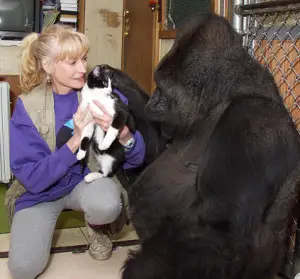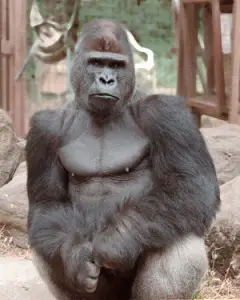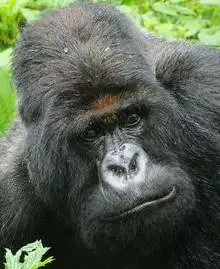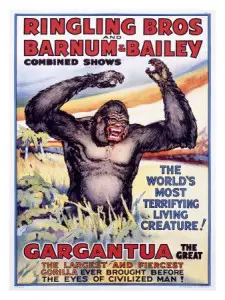Gorillas are ground-living and plant-eating apes. The name gorilla originated from the Greek word gorillas meaning tribe of hairy women. Gorillas are closely related to chimpanzees and human beings, sharing 98.4% of human genetic material. Zoologically the family Hoinoidea comprises of five genera including genus Homo for man, Pan for chimpanzees, Gorilla for gorilla and Pongo for orangutans. The genus Gorilla comprises of the Western Gorilla, Western Lowland Gorilla, Cross River Gorilla, Eastern Gorilla, Mountain Gorilla and Eastern Lowland Gorilla. The Western Lowland Gorillas live in swamps at sea level, in central west African countries, and Eastern Lowland Gorillas live in the Congo. The Mountain Gorillas live in the Albertine Rift and the montane cloud forests of the Virunga Volcanoes at altitudes 2,200-14,000 ft. In their native habitats gorillas live 35-40 years while in captivity they live for about fifty years. The western society came to know of gorillas in the 1860s and since then they have occupied a special place in the culture, predominantly through monstrous films like King Kong and Tarzan.
1. Digit

Digit, named after his broken middle finger, was a male mountain gorilla who was closely studied at Karisoke Research Center in Rawanda. The gorilla research station was founded by the famous primotologist Dian Fossey, who lived there from 1967 to 1985 when she was murdered and buried there. Digit became famous after the research work of Fossey and after being featured in the film Gorillas in the Mist. The adult silverback gorilla Digit was killed on the 1977 New Year’s Eve, while defending his family from the poachers’ attack. Dian Fossey was one of the three foremost primatologist, the other two being Jane Goodall and Galdikas. Fossey wrote many articles for National Geographic and founded Dian Fossey Gorilla Fund International for the protection and conservation of gorillas. Four years after the death of Digit, Fossey wrote ‘Digit’s killing was probably the saddest event in all the years that I had shared with the mountain gorillas… Digit was a favorite among the gorillas studied by me, and I’m not ashamed of him as my beloved digit to call. ”
2. Koko

Koko is a female gorilla, born on July 4, 1971, who was named Hanabiko, literally meaning fireworks child according to the Japanese tradition relating to this date. Koko is a short form of Hanabiko. She was born in the San Francisco Zoo and has lived mostly in Woodside, California. According to her long-term trainer, Francine Patterson, she can understand more than 1000 signs of the American Sign Language and understands about 2000 words of spoken English. Some researchers however disagree with Patterson’s opinion. They argue that Koko does not understand the meanings of the signs while Patterson maintains that she has documentary evidence for Koko’s capability. According to her no one taught her any sign for ring, but Koko invented it by combining the words finger and bracelet, giving finger bracelet for ring.
3. Michael Puig

Michael Puig was a silverback gorilla whose parents were killed by poachers. At the age of three years, he was brought to live with the famous female gorilla Koko. He was the first male gorilla who knew more than 600 signs in American Sign Language. He was taught by the female gorilla Koko, Dr. Francine Patterson, and other staff of Stanford University. He lived most of his lifetime in Woodside, California. He came into prominence for creating bold abstract paintings. Experts translated one message as pointing towards the event of his mother’s death at the hands of poachers.
4. Snowflake

Snowflake is a male albino white gorilla and is the only one white gorilla known so far. His captor originally named him Nfumu Ngui which means white gorilla in the Fang language. His keeper, Jordi Sabater Per, later on named him Floquet de Neu meaning little snowflake. The Mayor of Barcelona, Josep Maria de Porcioles, relieved him in November 1966. He called the gorilla Blancanieves, meaning snow white. Snowflake came into prominence when he appeared on the cover of National Geographic as Snowflake. He was captured by a farmer, Benito Marie, on October 1,1966 in the vicinity of Nko Equatorial forest nears Rio Campo, Equatorial Guinea.
5. Willie B

Willie B was a silverback gorilla, who lived in the Atlanta Zoo for thirty years, from 1961 until his death on February 2, 2000. He was named after the mayor of Atlanta, William Berry Hartsfield. Willie B lived for 27 years in isolation, only in the company of a television and a tire swing. He fathered five offspring at Atlanta Zoo. After the death of Willie B at the age of 41 years, his only male offspring was given the name of Willie B. Jr. as his heir and he led the troop. More than 8000 people attended his memorial ceremony and his bronze statue is displayed at the Atlanta Zoo.
6. Jenny

Jenny was a western lowland gorilla, confirmed by the International Species Information System as the oldest gorilla, who lived for 55 years. Her 55th birthday was celebrated in 2008 at the Dallas Zoo in Texas. She was born in the wild and lived a healthy life in captivity, weighing around 99 kgs. She gave birth to one daughter, Vicki, who was transferred to a zoo in Alberta Canada. During the last days of her life Jenny was diagnosed with an inoperable tumor and had stopped eating and drinking. She was therefore euthanized as a quality of life decision. Another gorilla, Colo, who was born in captivity, is currently 55 years old and considered the oldest gorilla after Jenny.
7. Titus

Titus was a silverback mountain gorilla of the Virunga Mountains. He was born on August 24, 1974 and died on September 14, 2009 at the age of 35 years. The famous primatologist Dian Fossey named him Titus after the protagonist of the Mervyn Peak novel Titus Groan. He is one of the most thoroughly researched gorillas. He was featured in the BBC documentary film, Titus: The Gorilla King. At the age of four years Titus was joined by a blackback male gorilla, named Beetsme by Fossey. When Uncle Bert, the father of Titus, was killed by poachers, Beetsme tried to take over the command of the troop, but Titus ultimately succeeded to retain the command himself.
8. Gargantua

Gargantua was a lowland gorilla, born wild in Belgian Congo in 1929. Missionaries in Africa gave him as a gift to Captain Arthur Phillips in 1930. The captain kept him on his freighter where all the crew except one liked him. This exceptional person, fed up with captain’s tyrannical behavior, therefore retaliated by throwing nitric acid on the gorilla’s face. He was badly injured and although the wounds healed afterwards they left a permanent scar on his face and forever turned him aggressive towards human beings. Initially known as Buddy, he was renamed Gargantua after the fictional Gargantua, a giant. He is credited with saving the Ringling Brothers’ Circus from imminent bankruptcy.
9. Guy the Gorilla

Guy the Gorilla was named after Guy Fawkes Night, as he arrived at the London Zoo on November 5, 1947, Guy Fawkes Night. He was a lowland gorilla known for his huge size and gentle nature. He was only 10 kgs at the time of his arrival and later on developed into a full size 240 kgs. He measured five feet and four inches tall. He was the most loved animal in 1960s in the London Zoo. Although fearsome in appearance, he was very gentle in nature. If a bird flew in his cage, he allowed the bird to sit on his palm and observed it very softly. The head taxidermist of the Natural History museum preserved his skin after his death and recreated his model, which was displayed in the museum’s Cadogan Gallery.
10. Massa

Massa was one of the few gorillas who lived over 54 years. He was born in the wild in Ghana and was brought to America at an early age. His first owner was Gertrude Lintz. Mrs. Lintz sold him to the Philadelphia Zoo. He weighed 400 pounds and spent the whole his life in the zoo. The film Buddy was based mainly on his life, although some points were taken from the life of another gorilla, Gargantua, who was also known as Buddy at that time. Massa died of a heart attack on December 30, 1984, a day after his birthday party was celebrated with a special cake and live Dixieland band.
Conclusion
Gorillas are highly intelligent and research studies show that gorillas can laugh, grieve, use tools and can learn sign language. They live in close-knit families. Researchers think that gorillas can think about the past and future. Human beings have always felt close to the gorillas, particularly after Darwin’s theory of evolution and the latest DNA research relating to genomes, the human genetic map, which is the strongest scientific evidence of this close relationship.










December 28, 2016 6:19 pm
where’s harambe
July 13, 2019 11:57 am
Who’s that? Never heard of Harambe
May 15, 2017 9:42 pm
The photo shown for Jenny is a MALE silverback.
Since about 1980, Koko is better known by far than Digit.
(It might help to update as Snowflake has died.)
July 13, 2019 11:56 am
Where is Ivan??? This list FAILED! Ivan was a Gorilla at the B&I in Tacoma,WA for years before being sent to Atlanta Zoo